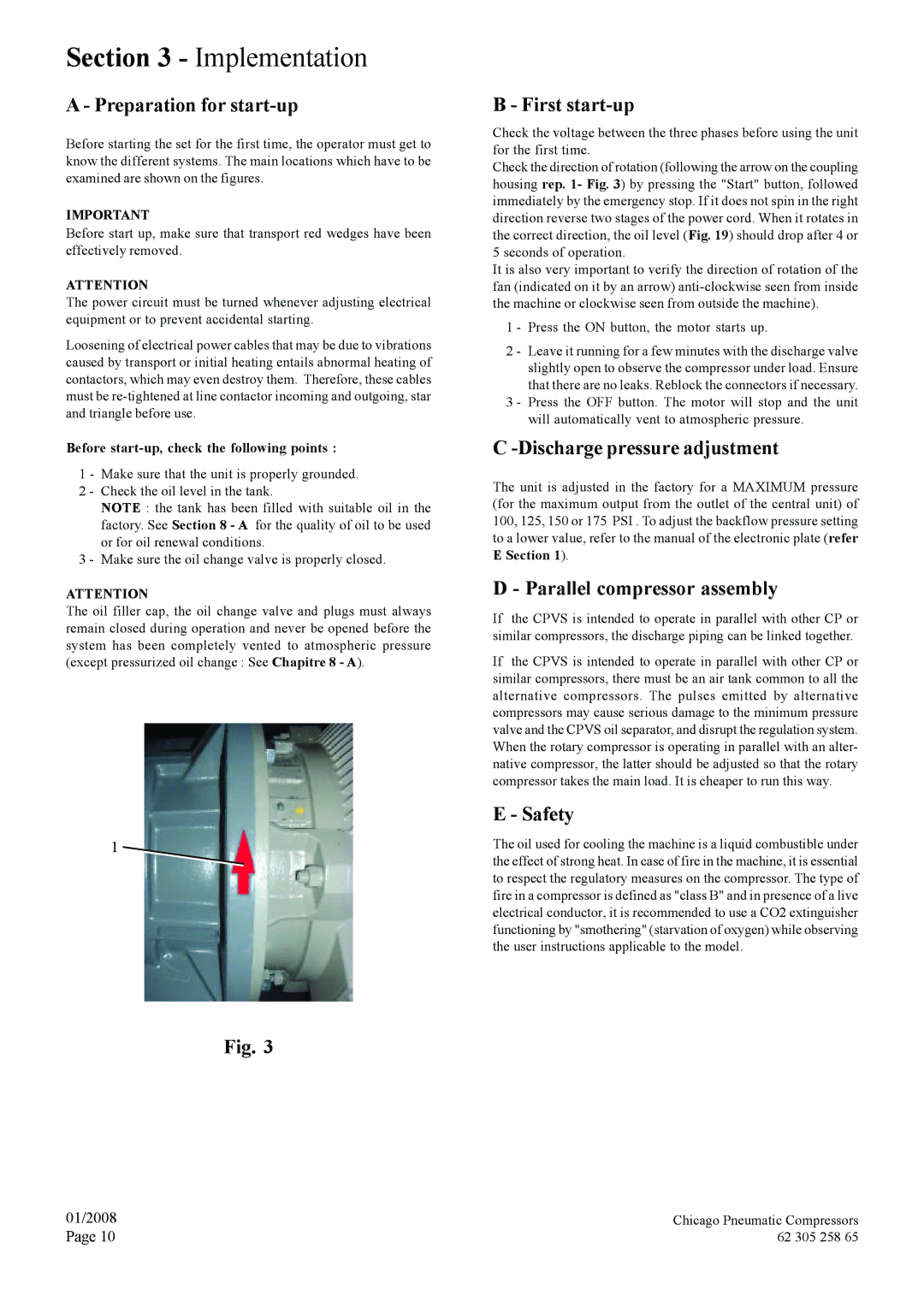
Section 3 - Implementation
A - Preparation for start-up
Before starting the set for the first time, the operator must get to know the different systems. The main locations which have to be examined are shown on the figures.
IMPORTANT
Before start up, make sure that transport red wedges have been effectively removed.
ATTENTION
The power circuit must be turned whenever adjusting electrical equipment or to prevent accidental starting.
Loosening of electrical power cables that may be due to vibrations caused by transport or initial heating entails abnormal heating of contactors, which may even destroy them. Therefore, these cables must be
Before start-up, check the following points :
1 - Make sure that the unit is properly grounded.
2 - Check the oil level in the tank.
NOTE : the tank has been filled with suitable oil in the factory. See Section 8 - A for the quality of oil to be used or for oil renewal conditions.
3 - Make sure the oil change valve is properly closed.
ATTENTION
The oil filler cap, the oil change valve and plugs must always remain closed during operation and never be opened before the system has been completely vented to atmospheric pressure (except pressurized oil change : See Chapitre 8 - A).
1
Fig. 3
B - First start-up
Check the voltage between the three phases before using the unit for the first time.
Check the direction of rotation (following the arrow on the coupling housing rep. 1- Fig. 3) by pressing the "Start" button, followed immediately by the emergency stop. If it does not spin in the right direction reverse two stages of the power cord. When it rotates in the correct direction, the oil level (Fig. 19) should drop after 4 or 5 seconds of operation.
It is also very important to verify the direction of rotation of the fan (indicated on it by an arrow)
1 - Press the ON button, the motor starts up.
2 - Leave it running for a few minutes with the discharge valve slightly open to observe the compressor under load. Ensure that there are no leaks. Reblock the connectors if necessary.
3 - Press the OFF button. The motor will stop and the unit will automatically vent to atmospheric pressure.
C -Discharge pressure adjustment
The unit is adjusted in the factory for a MAXIMUM pressure (for the maximum output from the outlet of the central unit) of 100, 125, 150 or 175 PSI . To adjust the backflow pressure setting to a lower value, refer to the manual of the electronic plate (refer E Section 1).
D - Parallel compressor assembly
If the CPVS is intended to operate in parallel with other CP or similar compressors, the discharge piping can be linked together.
If the CPVS is intended to operate in parallel with other CP or similar compressors, there must be an air tank common to all the alternative compressors. The pulses emitted by alternative compressors may cause serious damage to the minimum pressure valve and the CPVS oil separator, and disrupt the regulation system. When the rotary compressor is operating in parallel with an alter- native compressor, the latter should be adjusted so that the rotary compressor takes the main load. It is cheaper to run this way.
E - Safety
The oil used for cooling the machine is a liquid combustible under the effect of strong heat. In case of fire in the machine, it is essential to respect the regulatory measures on the compressor. The type of fire in a compressor is defined as "class B" and in presence of a live electrical conductor, it is recommended to use a CO2 extinguisher functioning by "smothering" (starvation of oxygen) while observing the user instructions applicable to the model.
01/2008 | Chicago Pneumatic Compressors |
Page 10 | 62 305 258 65 |
